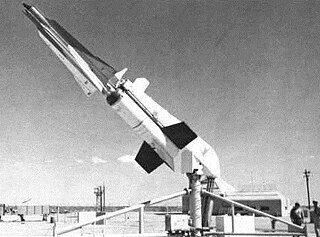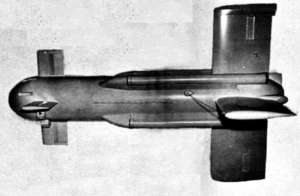
In 1962, the U.S. Navy issued a requirement for a long-range high-precision air-to-surface missile. The missile, named the AGM-53A Condor, was to use a television guidance system with a data link to the launching aircraft similar to the system of the then projected AGM-62 Walleye.

Bendix RIM-8 Talos was a long-range naval surface-to-air missile (SAM), among the earliest SAMs to equip United States Navy ships. The Talos used radar beam riding for guidance to the vicinity of its target, and semi-active radar homing (SARH) for terminal guidance. The four antennas surrounding the nose were SARH receivers, which functioned as a continuous wave interferometer. A solid rocket booster provided initial thrust for launch; a Bendix ramjet provided for flight to the target, with the warhead serving as the ramjet's compressor.

Operation Bumblebee was a US Navy effort to develop surface-to-air missiles (SAMs) to provide a mid-range layer of anti-aircraft defense between anti-aircraft guns in the short range and fighter aircraft operating at long range. A major reason for the Bumblebee efforts was the need to engage bombers before they could launch standoff anti-shipping weapons, as these aircraft might never enter the range of the shipboard guns.

The Gorgon missile family was a series of experimental air-to-air, air-to-surface, and surface-to-surface missiles developed by the United States Navy's Naval Aircraft Modification Unit between 1943 and 1953. The immaturity of the technology involved meant that none of the Gorgon missiles achieved operational service, however they were extensively used in the development of guided missile controls and guidance technologies.

Project Kingfisher was a weapons-development program initiated by the United States Navy during the latter part of World War II. Intended to provide aircraft and surface ships with the ability to deliver torpedoes to targets from outside the range of defensive armament, six different missile concepts were developed; four were selected for full development programs, but only one reached operational service.

The LBD-1 Gargoyle was an American air-to-surface missile developed during World War II by McDonnell Aircraft for the United States Navy. One of the precursors of modern anti-ship missiles, it was extensively used as a test vehicle during the late 1940s.

The Brazo missile was an American project of the 1970s, intended to produce an anti-radiation missile for air-to-air use. Developed by Hughes Aircraft and based on the AIM-7 Sparrow air-to-air missile, the Brazo underwent a series of successful test firings; however, the program was terminated at the end of its test program.

Typhon was a missile system developed by the United States Navy in the late 1950s, intended to serve as an integrated air-defense system for Navy fleets. Consisting of the SAM-N-8 Typhon LR, later designated RIM-50A, and the SAM-N-9 Typhon MR, later RIM-55A, paired with the AN/SPG-59 radar system, the cost of the Typhon system led to it being cancelled in favor of the Standard Missile program.

The RGM-59 Taurus was an American project, conducted by the United States Navy, that was intended to develop a surface-to-surface missile for use as a fire support weapon during amphibious landings, replacing heavy-caliber naval guns. Developed during the early 1960s, the project was cancelled before any hardware development was undertaken.

The Hopi was an air-to-surface missile developed by the United States Navy's Naval Ordnance Test Station. Intended to provide a medium-range nuclear capability for carrier aircraft, the missile reached the flight test stage during 1958, but the project was cancelled following testing and no production was undertaken.

The 3.5-inch Forward Firing Aircraft Rocket, or 3.5-Inch FFAR, was an American rocket developed during World War II to allow aircraft to attack enemy submarines at range. The rocket proved an operational success, and spawned several improved versions for use against surface and land targets.

The JB-4, also known as MX-607, was an early American air-to-surface missile developed by the United States Army Air Forces during World War II. Using television/radio-command guidance, the JB-4 reached the flight-testing stage before being cancelled at the end of the war.

The AAM-A-1 Firebird was an early American air-to-air missile, developed by the Ryan Aeronautical Company. The first air-to-air missile program developed for the United States Air Force, the Firebird was extensively tested in the late 1940s; although it proved successful in testing, it was soon obsolete due to the rapid advances in aircraft and missile technology at the time and did not enter production.
The ASM-N-5 Gorgon V was an unpowered air-to-surface missile, developed by the Glenn L. Martin Company during the early 1950s for use by the United States Navy as a chemical weapon delivery vehicle. Developed from the earlier PTV-N-2 Gorgon IV test vehicle, the program was cancelled without any Gorgon Vs seeing service.

The Fairey Aviation Stooge was a command guided surface-to-air missile (SAM) development project carried out in the United Kingdom starting in World War II. Development dates to a British Army request from 1944, but the work was taken over by the Royal Navy as a potential counter to the Kamikaze threat. Development was not complete when the war ended, but the Ministry of Supply funded further development and numerous test launches into 1947, assisting in the development of more advanced successor missiles.

The AAM-N-4 Oriole was an early American air-to-air missile, developed by the Glenn L. Martin Company for the United States Navy. Designed for launch from carrier-based aircraft, the missile programme was cancelled before flight testing began, and the missiles produced were utilized as test vehicles.

The AAM-N-5 Meteor was an early American air-to-air missile, developed by the Massachusetts Institute of Technology and Bell Aircraft for the United States Navy. Initially, both air-launched and ship-launched versions were considered. Versions designed for launch from carrier-based aircraft proceeded to the flight testing stage before the project was cancelled.
The SSM-N-2 Triton was a supersonic nuclear land-attack cruise missile project for the United States Navy. It was in development from 1946 to 1957, but probably no prototypes were produced or tested. The Triton program was approved in September 1946, designated SSM-2 a year later, and redesignated SSM-N-2 in early 1948. A preliminary design was produced by 1950 as the XSSM-N-2, but was scaled down by 1955 and redesigned again in 1957. Triton was cancelled in 1957, probably as a result of the 1956 decision to focus the Navy's strategic weapons development on the Polaris submarine-launched ballistic missile. In any case, prototypes of the similar Regulus II missile had already flown, and Triton was redundant, offering only an increase in range from 1,000 nautical miles (1,900 km) to 1,500 nautical miles (2,800 km), which Polaris was about to achieve along with many other advantages. Regulus II was itself cancelled in 1958, although testing of missiles already built continued for several years.

The CTV-N-2 Gorgon IIC – also designated KGN, KUN, and CTV-2 – was an experimental drone, originally intended as a surface-to-surface missile, developed by the United States Navy near the end of World War II. It was used to test control and homing systems for guided missiles, and was also produced in small numbers as a target drone under the designations TD3N and KD2N.

The AAM-N-10 Eagle was a long-range air-to-air missile developed by the Bendix Corporation for use by the United States Navy. Intended for carriage by the Douglas F6D Missileer fleet defense fighter, the Eagle program was cancelled before testing could begin, but the lessons learned were used in the development of the AIM-54 Phoenix missile.



















